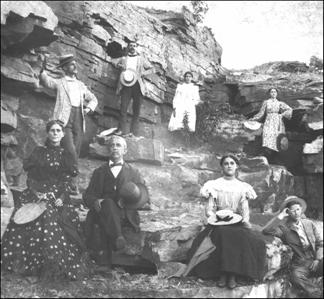

By Elizabeth Short
Arkansas Gazette, June 25, 1989
B
ALD KNOB – The acre-big sandstone rock resembled a giant washtub turned upside-down and partially buried. It was round with fairly flat top. It had
stood for eons. The area around the big rock was sparsely populated before the Civil War. To the east and north, big virgin timber covered the
hillsides – oak, hickory, sweet gum, elm and cedar. But the timber was worthless because there was no way to transport it. To the south, vast
acres of canebrakes led into the Little Red River and White River bottoms.
There was no town then. The few inhabitants lived around Shady Grove church-schoolhouse a few miles north of the rock. They sere subsistence
farmers who drove their cattle into the river bottoms to graze.
In the spring, the rock, known throughout White County as “the knob,” “the big rock,” or “the bald knob rock,” became a gathering point. Cattlemen
would bring their herds to pens beside the rock. There they would brand calves, salt the herds, and sell and trade cattle.
The western part of White County had been settled for some time. Searcy was incorporated in 1837 and Judsonia in 1852. Augusta, to the southwest,
was founded in 1848 and was a thriving river town. But the big rock was isolated from rivers and roads.
In February 1873, a railroad was completed through Arkansas from north to south. It was built by the Cairo and Fulton Railroad Co. and it
connected the rock with the rest of the world. Time began running out for the great rock.

By 1876, the Cairo and Fulton merged with the St. Louis, Iron Mountain and Southern Railroad and had taken the name of the latter company.
The railroad had laid miles of tracks, but still had not undertaken the huge job of putting ballast rock around and under the track to make
it stable. Railroaders knew that would take a lot of rock. As they rode past “the bald knob rock,” they eyed it as a source of ballast, and
leased the ground from Michael Howard and B.D. Turner.
About this John Kerr built the first sawmill in the area and began cutting timber. John Bradford came too, to log the woods. With them the
area’s timber industry was born. And the big rock began to be quarried for railroad ballast. Between 1876 and 1878 men from the North and
East, many of the immigrants from foreign countries, flocked to work in the rock quarry. In 1876, there had been nothing but a rock. In
February 1878, Lunsford Worthington applied for a post office in the village of Bald Knob, listing 158 families who would be served by the post
office. In a few short years, the timber, railroad and quarry had created a bustling town. The 1880 census listed 221 residents, with 51 of them
quarry workers. The census shows teamsters, saloons, hotels

,
blacksmiths, a doctor, a druggist, tailor and butcher. On September 16, 1881, a
petition to incorporate the town of Bald Knob was signed by 37 men. Yet its namesake was disappearing. Quarrying of the big rock went on
for at least 20 years, but by 1900 the census showed only two men as quarry
workers.
Finally, the big rock disappeared. It had been turned into fragments lining hundreds of miles of railroad.
The site where it once stood is at the end of Center Street, just south of state Highway 367. Some residents still get a twinge of sadness looking
at it. The mass of sandstone served as a gathering place; it provided miles of ballast for Arkansas railroads; and it gave birth to a town.
vvv



 ,
blacksmiths, a doctor, a druggist, tailor and butcher. On September 16, 1881, a
petition to incorporate the town of Bald Knob was signed by 37 men. Yet its namesake was disappearing. Quarrying of the big rock went on
for at least 20 years, but by 1900 the census showed only two men as quarry
workers.
,
blacksmiths, a doctor, a druggist, tailor and butcher. On September 16, 1881, a
petition to incorporate the town of Bald Knob was signed by 37 men. Yet its namesake was disappearing. Quarrying of the big rock went on
for at least 20 years, but by 1900 the census showed only two men as quarry
workers.